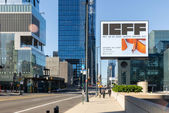RE-COMPOST, 2025
New York, NY
Winner of ICFF WantedDesign Workshop
Issued by WantedDesign and ICFF · May 2025
Recognized as part of the winning team of the 2025 ICFF WantedDesign Workshop. Our group, Re-Compost, was awarded first place for a proposal reimagining New York City’s composting system through a circular, community-centered, and regenerative approach. The project explored multi-scalar design strategies across physical, digital, and educational layers, and was developed in collaboration with peers from RISD, CCA, SVA, EMH, and Pratt Institute.
Gabriela Mestriner (Pratt Institute), Florence Grace-Castonguay (RISD), Gabriela Mierkalne (CCA), Rida Zeng (SVA), Sebastian Arce (EMH)

New York City made composting mandatory in April 2025 — a major step toward reducing landfill waste. However, the city’s current system, though expansive, lacks a truly circular approach. Most organic waste collected through the official smart orange bins is sent to industrial digesters and, due to the inclusion of a broader range of materials and contamination, often ends up in landfills rather than returning to the soil.
At the same time, NYC has long benefited from a rich ecosystem of community composting initiatives. Over 200 decentralized sites across the city — from Governors Island to Bushwick — collect food scraps and turn them into nutrient-rich compost that’s redistributed through seedling swaps, tree-bed top-ups, school gardens, and public workshops. These localized efforts build knowledge, foster community, and regenerate the urban landscape. Yet, since the citywide mandate, these initiatives have seen a dramatic drop in food waste input, as more residents now use the official bins. As a result, the community hubs are left under-resourced, and the materials that once sustained them are diverted elsewhere.
This proposal responds to that shift by reimagining New York’s composting system as a truly regenerative and participatory cycle — one that ensures all organic waste not only gets collected, but also returns to the soil and the communities that need it most. Rather than starting from scratch, our design builds on existing infrastructure — including the city’s smart bins, digital app, and collection network — and reconnects them with local composting organizations through three integrated layers: Physical, Digital, and Educational.
Physical Layer
We propose a modular redesign of the smart bins, transforming them from passive collection points into active community touchpoints. In their simplest form, bins are topped with planters filled with composted soil, grown entirely from New York’s organic waste. Protected by metal grids, these plants visually demonstrate the results of composting and bring greenery to the streetscape.
Larger units integrate seating, soil dispensers, and educational signage — allowing residents who contribute their food waste to choose whether to take compost home or donate it to local gardens. Informative stickers and printed guides explain how to access the app, what happens to their waste, and how to engage with nearby initiatives. These physical modules vary in scale depending on the site: from compact interventions on narrow sidewalks to extended corner installations with seating and community use.
Digital Layer
To support and unify the system, we enhance the existing city app into a tool of reciprocity and engagement. Beyond unlocking bins and tracking collection, the app now allows users to choose what happens to their contribution — retrieve soil, donate it, or link with local gardens. It centralizes knowledge about composting, provides updates on bin status, and connects to community-led programs.
The app also integrates broader food-related services. Residents can learn about food donation, waste reduction strategies, and community fridges — creating a hub that brings together organic waste, food redistribution, and neighborhood collaboration. This shift from utility to platform empowers users to take part in the system at multiple levels.
Educational Layer
The final layer operates across both physical and digital scales, making composting tangible and accessible. On the street, passersby see and touch the composted soil, learn where it’s going, and understand the system they’re part of. Digitally, users are guided through workshops, local events, and learning modules — building literacy in waste management and climate-conscious behavior.
By putting soil — the very outcome of composting — at the center of our intervention, we create a point of contact between individuals and ecological systems. For many urban residents, composting feels distant or abstract. This system shifts that perception by returning value to the user and grounding composting in everyday experience.
A Systemic Proposal
This project addresses a citywide issue through local action. It retools the infrastructure to function not as a linear chain, but as a regenerative loop. It works across scales — from the design of a single bin to the behavior of entire communities — and integrates policy, technology, and place-based engagement into one coherent system.
You give, you get becomes more than a slogan. It represents a cultural shift — one where food waste is no longer discarded, but transformed into something of value: fertile soil, thriving gardens, and stronger communities.






